
What’s in Jet A1 Fuel? Composition Explained
At GLOBAL TERMINAL NETHERLANDS B.V, we understand the importance of Jet A1 fuel in aviation. This specialized fuel powers countless aircraft worldwide, but its composition remains a mystery to many.
In this post, we’ll explore the Jet A1 fuel composition, breaking down its key components and additives. We’ll also delve into its properties, safety considerations, and future developments in aviation fuel technology.
What’s Inside Jet A1 Fuel?
Jet A1 fuel powers modern aviation, serving as a complex mixture optimized for aircraft engine performance. This chapter explores the key components and additives that make up this essential fuel.
The Kerosene Foundation
Aviation jet fuels contain over a thousand different hydrocarbons, making the prediction of their properties from chemical composition difficult. This petroleum-derived product contains hydrocarbon chains with 8 to 16 carbon atoms, providing the high energy density necessary for efficient air travel.
Hydrocarbon Chains: The Power Source
Jet A1 fuel’s hydrocarbon chains balance carefully to ensure optimal performance across various flight conditions. These chains include a mix of straight-chain alkanes, branched alkanes, and aromatic compounds. The specific ratio of these hydrocarbons affects critical properties like freezing point and energy content. Branched alkanes, for example, help maintain fuel flow at high altitudes where temperatures can plummet to -40°C or lower.
Essential Additives
While kerosene dominates the composition, additives play a vital role in enhancing Jet A1 fuel’s performance and safety. These include:
- Static dissipators: These prevent the buildup of static electricity during fuel transfer, reducing the risk of sparks and potential explosions.
- Antioxidants: These slow down the fuel’s degradation process, extending its shelf life.
- Corrosion inhibitors: These protect fuel system components from rust and degradation, ensuring long-term reliability of aircraft engines.
- Metal deactivators: These prevent metal ions from catalyzing oxidation reactions, which could lead to fuel instability.
The ASTM D1655 specification defines the minimum property requirements for Jet A and Jet A-1 aviation turbine fuel and lists acceptable additives for use in civil and military operated engines and aircraft.
The Importance of Composition
Understanding Jet A1 fuel’s composition proves essential for everyone involved in aviation fuel management. It’s not just about storing a liquid; it’s about maintaining a carefully engineered product that powers global air travel. This knowledge allows for better appreciation of the complexity behind every flight and the importance of proper fuel handling and storage.
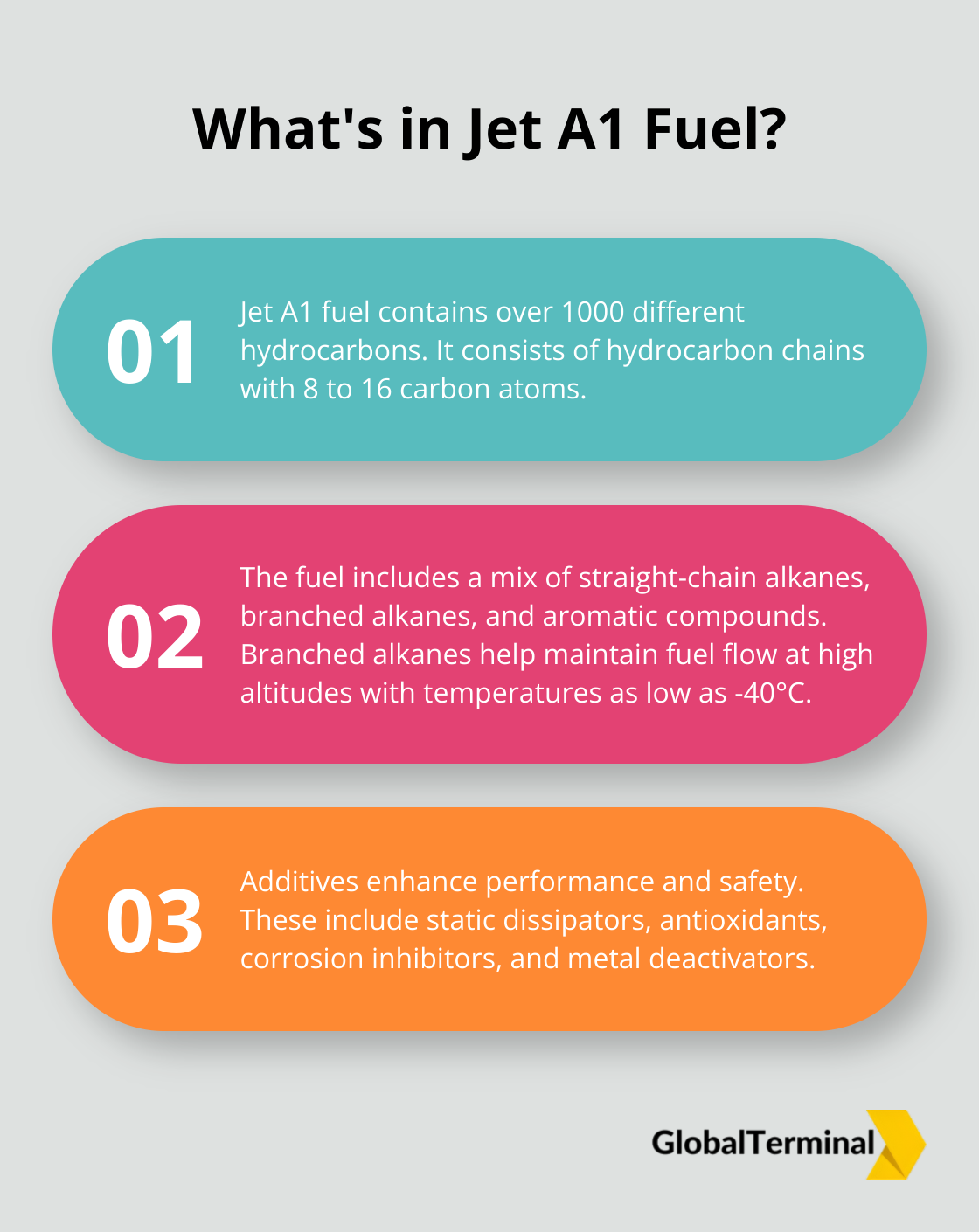
The next chapter will explore the properties and characteristics of Jet A1 fuel, building on this foundation of its composition.
What Makes Jet A1 Fuel Unique?
Flash Point and Freezing Point
Jet A1 fuel stands out with its flash point above 38°C, which surpasses that of gasoline. This higher flash point boosts safety during handling and storage, minimizing accidental ignition risks. The International Air Transport Association (IATA) emphasizes the importance of this safety feature in airport environments where fuel handling occurs frequently.
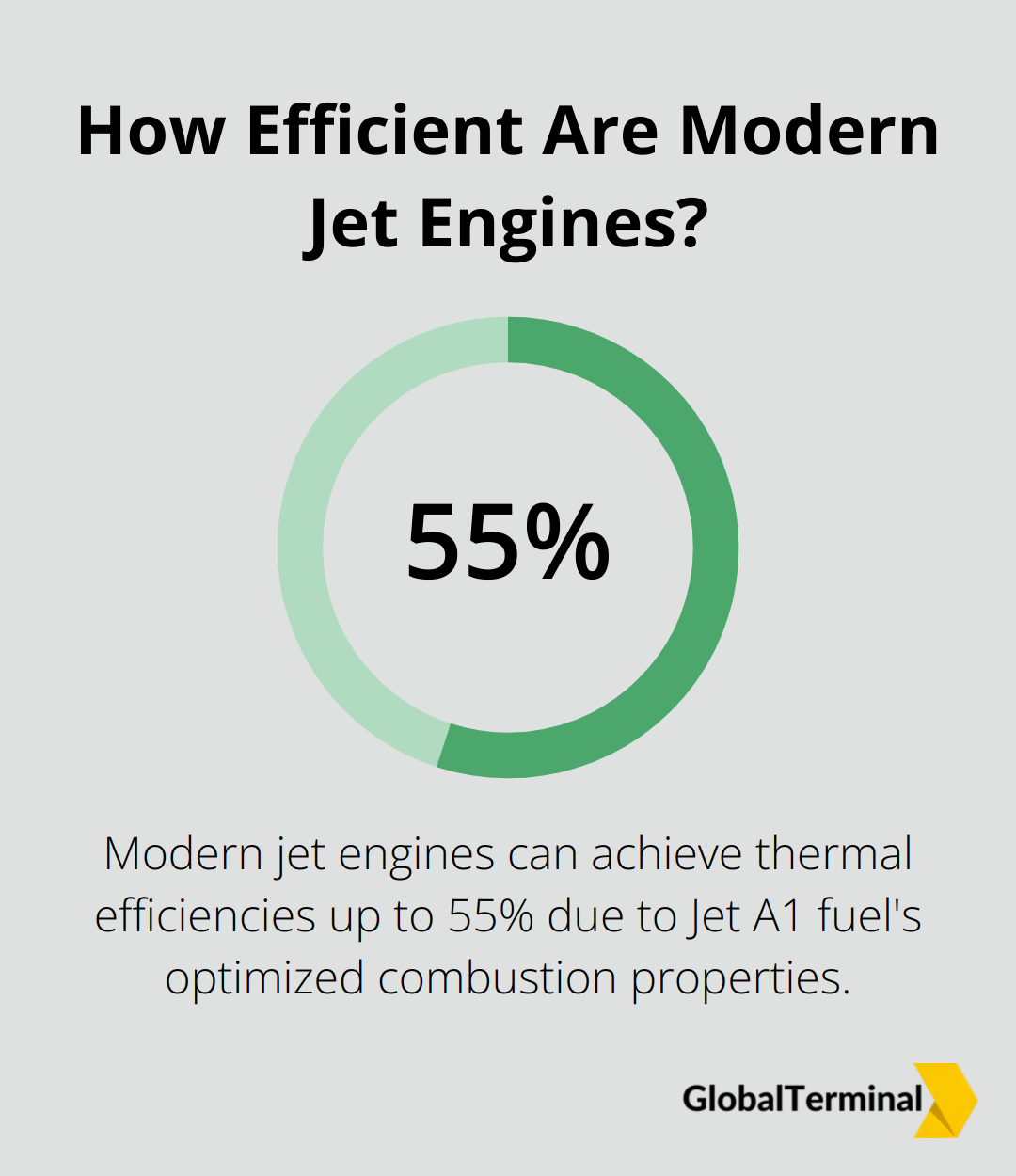
At the opposite end of the temperature spectrum, Jet A1 maintains a freezing point of -47°C (-52.6°F). This low freezing point proves essential for high-altitude flights where outside temperatures drop dramatically. Boeing reports that commercial aircraft typically cruise at altitudes between 31,000 and 38,000 feet, encountering temperatures from -40°C to -57°C.
Energy Content and Combustion Efficiency
Jet fuel, also known as aviation turbine fuel (ATF), is designed for use in aircraft powered by gas-turbine engines. This high energy density translates to improved fuel efficiency and extended flight ranges. The International Civil Aviation Organization (ICAO) reports that modern jet engines can achieve thermal efficiencies up to 55%, largely due to Jet A1 fuel’s optimized combustion properties.
The fuel’s low viscosity further enhances combustion efficiency, allowing for fine atomization in jet engine combustion chambers. This results in more complete fuel burning, which reduces emissions and improves overall engine performance.
Stability and Storage Requirements
The stability of Jet A1 fuel plays a key role in long-term storage and consistent performance. Under proper storage conditions, the fuel typically maintains its quality for up to a year without significant degradation.
Temperature control proves vital in Jet A1 storage. The fuel should remain at temperatures between 10°C and 30°C to prevent condensation and maintain fuel integrity. Humidity control holds equal importance, as moisture can lead to microbial growth and fuel degradation.
Regular testing ensures fuel quality. The American Society for Testing and Materials (ASTM) recommends monthly checks for water content, particulate matter, and microbial contamination. These tests help maintain compliance with the stringent ASTM D1655 specifications.
Proper storage also involves using materials compatible with Jet A1 fuel. Stainless steel tanks (preferred for their resistance to corrosion and contamination) and floating roofs in storage tanks help minimize fuel exposure to air, reducing oxidation risks and maintaining fuel quality.
The unique properties of Jet A1 fuel demand specialized handling and storage practices. In the next chapter, we will explore the safety measures and handling procedures necessary to manage this powerful aviation fuel effectively.
How to Handle Jet A1 Fuel Safely
Secure Storage and Transportation
Jet A1 fuel requires meticulous handling to ensure safety, efficiency, and environmental protection. Proper storage starts with the right containers. Stainless steel or aluminum tanks are used to prevent leaks and are riveted together. These tanks should have floating roofs to minimize fuel exposure to air, which reduces oxidation risks.
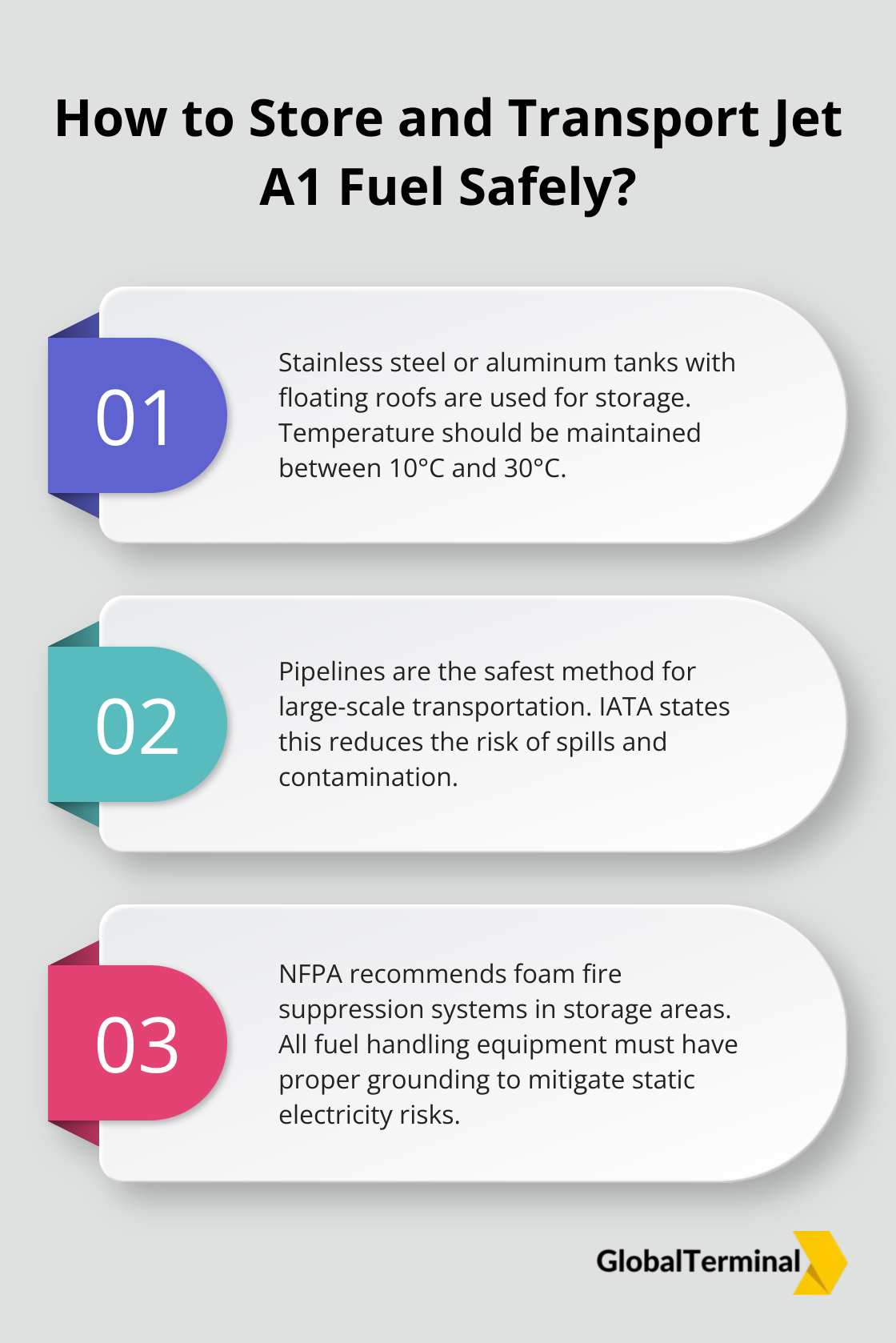
Temperature control plays a vital role. The U.S. Energy Information Administration advises maintaining Jet A1 fuel between 10°C and 30°C to prevent condensation and preserve fuel integrity. Humidity control is equally important, as moisture can lead to microbial growth and fuel degradation.
For transportation, dedicated pipelines offer the safest and most efficient method for large-scale movement. The International Air Transport Association (IATA) states that pipeline transport reduces the risk of spills and contamination compared to road or rail alternatives.
Fire Safety Protocols
Fire safety is paramount when handling Jet A1 fuel. The National Fire Protection Association (NFPA) recommends foam fire suppression systems in storage areas. These systems can quickly smother fuel fires, preventing rapid spread.
Static electricity poses a significant ignition risk. To mitigate this, all fuel handling equipment must have proper grounding. The Petroleum Equipment Institute suggests using conductive hoses and bonding wires to ensure electrical continuity during fuel transfers.
Regular fire drills and staff training are essential. The Occupational Safety and Health Administration (OSHA) mandates that all personnel handling Jet A1 fuel receive comprehensive fire safety training at least annually.
Environmental Protection Measures
Spill prevention and management are critical for environmental protection. The U.S. Environmental Protection Agency (EPA) requires facilities storing over 1,320 gallons of oil products (including Jet A1 fuel) to have a Spill Prevention, Control, and Countermeasure (SPCC) plan.
Secondary containment systems, such as dikes or berms around storage tanks, can prevent widespread environmental contamination in case of a spill. These systems should hold at least 110% of the largest tank’s capacity, as per EPA guidelines.
In the event of a spill, quick response is vital. The International Petroleum Industry Environmental Conservation Association (IPIECA) recommends having spill kits readily available and training staff in their use. These kits typically include absorbent materials, protective equipment, and containment booms.
Final Thoughts
Jet A1 fuel, with its complex composition of hydrocarbons and additives, powers modern aviation. This kerosene-based fuel provides high energy density and performance characteristics necessary for efficient air travel. Its low freezing point and high flash point make it suitable for a wide range of flight conditions, from high-altitude cruising to ground-level handling.
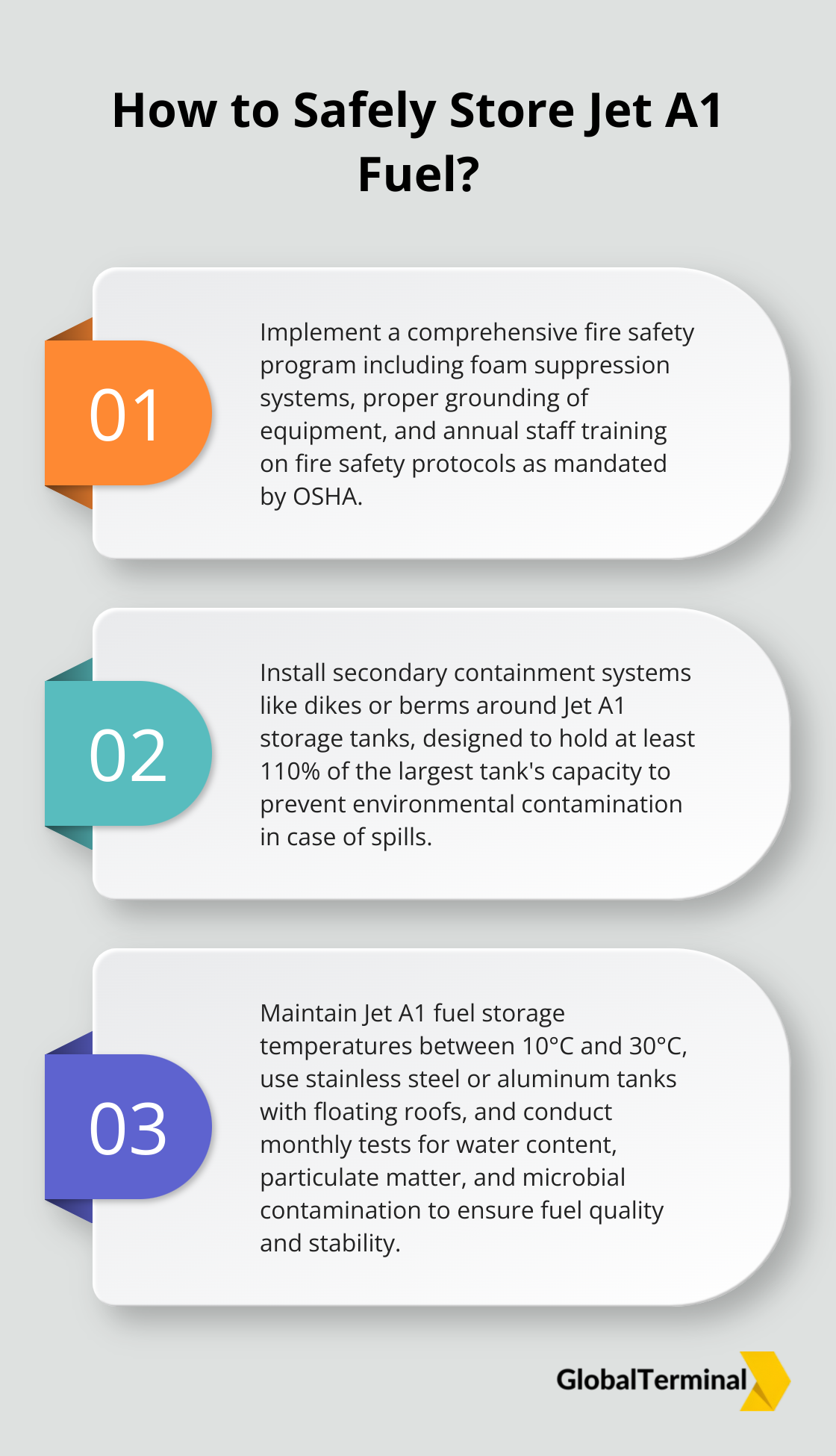
The aviation industry actively explores future developments in fuel technology, with sustainable aviation fuels (SAFs) gaining traction as a promising alternative. These biofuels, derived from renewable sources, have the potential to reduce the carbon footprint of air travel while maintaining performance standards. As the sector evolves, companies like GLOBAL TERMINAL NETHERLANDS B.V play a crucial role in ensuring safe storage and efficient distribution of aviation fuels.
Understanding Jet A1 fuel composition and properties is essential for everyone involved in aviation, from fuel handlers to pilots. This knowledge enhances safety and paves the way for innovations in fuel technology. The aviation industry will continue to refine and improve jet fuels, balancing performance, safety, and environmental considerations to power the next generation of air travel.

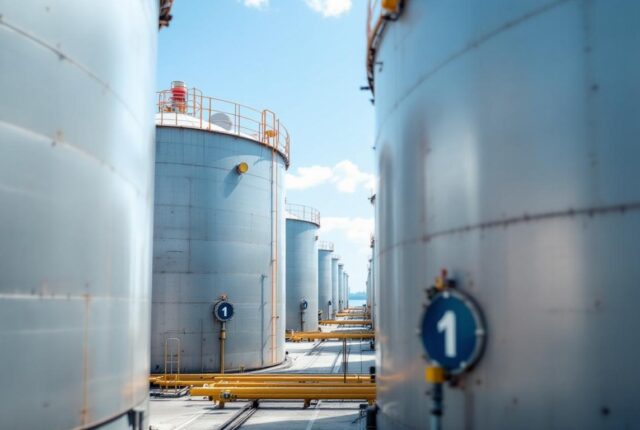
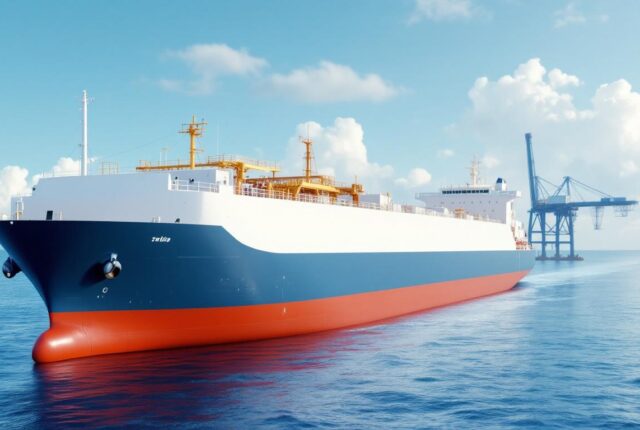
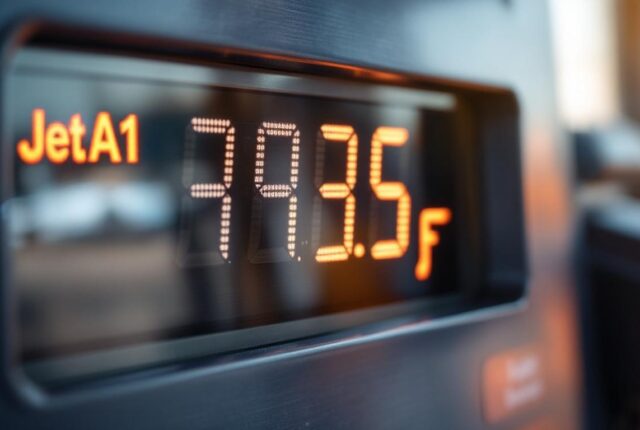

Leave a Reply